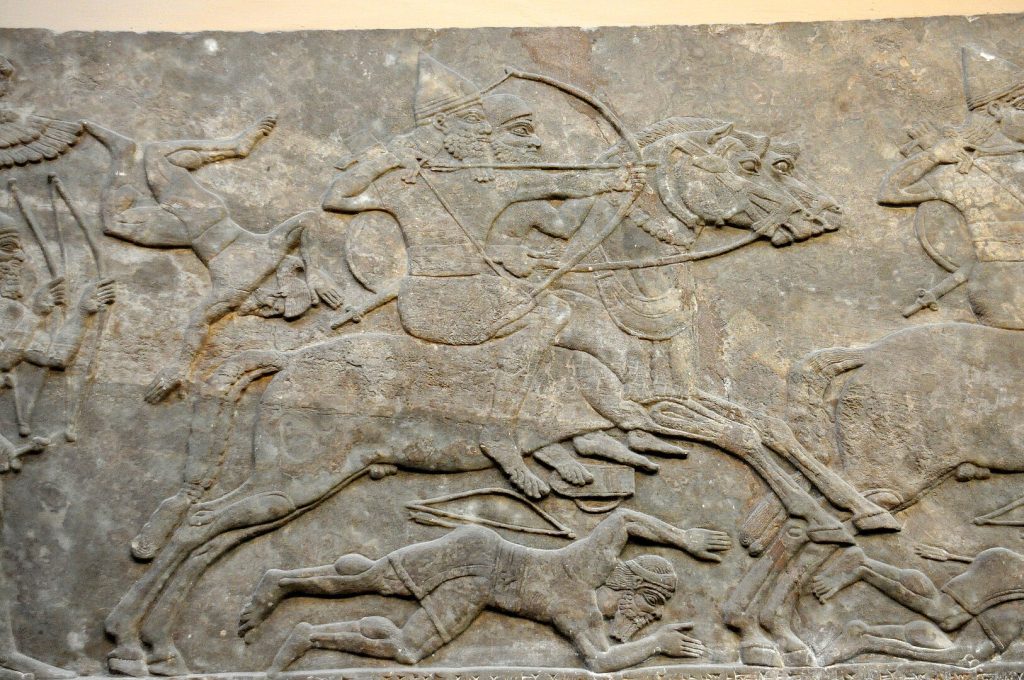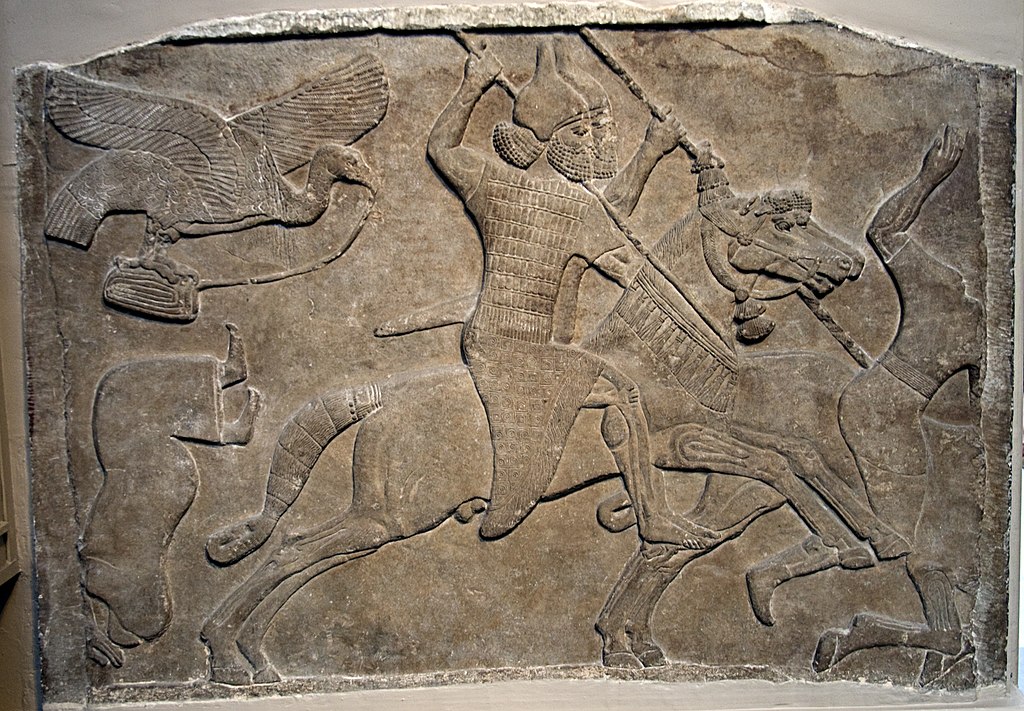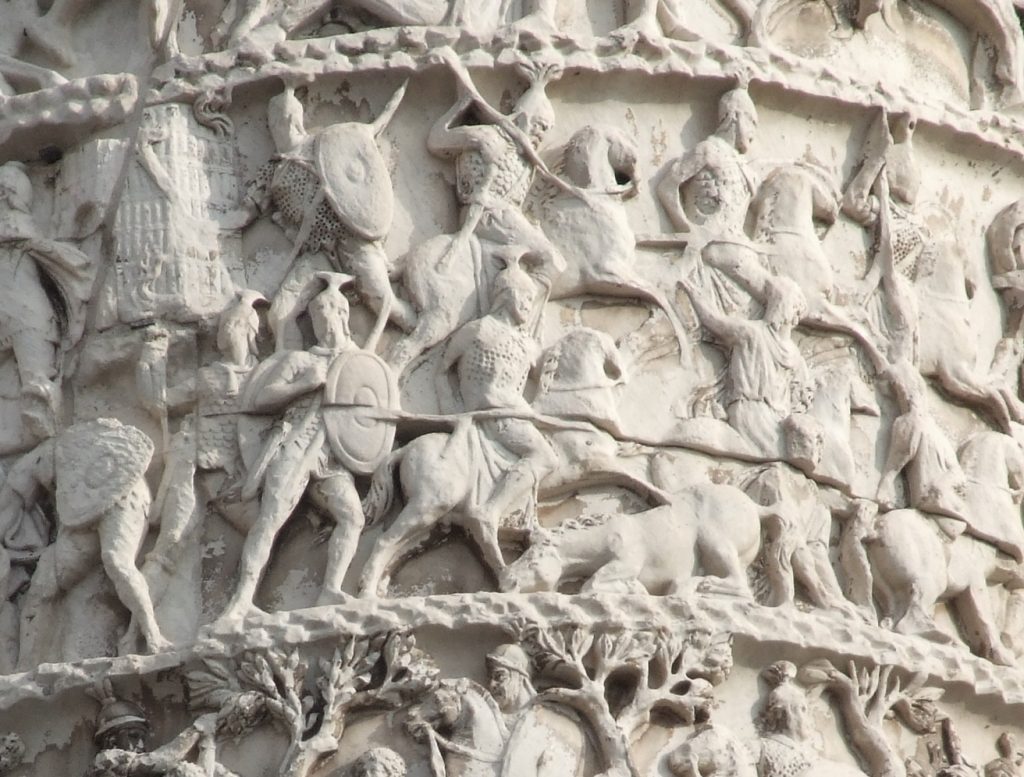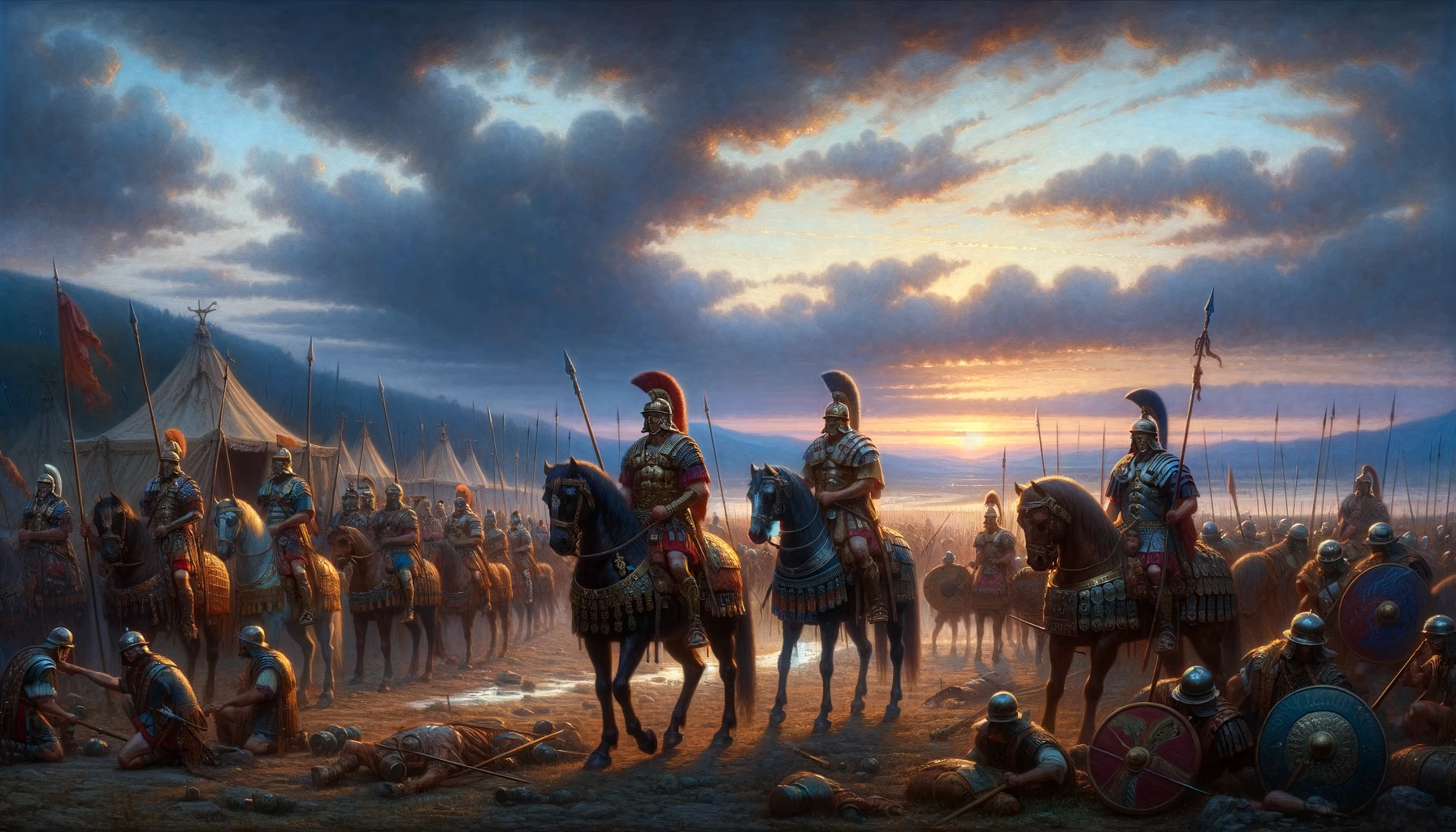The adaptability of the Romans in incorporating foreign military practices to enhance their legionary structure, weaponry, and battle strategies is extensively recognized and discussed among modern historians. Yet, one area that has been somewhat overlooked is their efforts to cultivate a potent cavalry force throughout the Empire. In pursuit of this goal, the Romans explored diverse cavalry types and tactics, leading to the significant innovation of the mailed cavalry.
Pre Roman Cavalry
The Roman cavalry force, emerging prominently after the first century A.D., drew on prior Mediterranean experiments with cavalry gear and methods. The heavy-armoured horseman, though not a Roman invention but that of the Assyrians, whose historical records reveal early cavalry advancements, serves as a crucial reference point. The Assyrian cavalry’s evolution offers insights into the challenges and solutions that would later inform Roman military strategy, with striking parallels in the types of cavalry and tactics employed.

By the ninth century B.C., Assyrian reliefs from the reign of Ashurnasirpal II show unarmoured mounted archers, indicating a response to nomadic threats through comparable mounted units. This adaptation reflects not an invention but an assimilation of nomadic tactics, leveraging available resources like the domesticated horse and converting infantry archers to mounted ones, marking a revolutionary shift in military composition. However, the Assyrian mounted archer, while more mobile, remained vulnerable, prompting the development of cavalry armour, as evidenced in the portrayals of Tiglath-Pileser III’s era, showcasing riders in mail shirts.

Simultaneously, in central Asia, the Massagetae and Chorasmians were undertaking parallel innovations in cavalry warfare, culminating in the prototype of the cataphract, a heavily armoured rider, distinct for also attempting to shield the horse. This development necessitated a robust, agile breed of horse, speculated to have originated from Turan and identifiable in the well-preserved Pazyryk horses of the Altai Mountains.
While the Assyrians and Chorasmians managed without saddles and stirrups, these enhancements would have augmented a rider’s stability and manoeuvrability, suggesting that ancient cavalry could still be effective in battle through skilled horsemanship. These early endeavours in cavalry development underscore the lasting impact of Assyrian and Chorasmian strategies on military innovation, setting precedents for later Eastern and, notably, Roman cavalry formations, as the Romans began to adopt and adapt these mailed cavalry models during the early Empire, drawing from a rich history of cavalry evolution across the ancient world.
Cavalry in the Early Republic
During the early Republic, detached from the military innovations of the East, Rome had yet to face the challenge of mailed cavalry until their conflict with Antiochus III. In the battle of Magnesia, despite their lack of prior experience with such forces, the Romans were neither intimidated nor defeated by Antiochus’s 3,000 cataphracts; in fact, these units proved to be ineffective against Roman legions.
Given this outcome, it seemed improbable that Rome would swiftly embrace the defeated enemy’s military techniques and equipment. However, by the early second century B.C., shortly after Magnesia, a significant overhaul of the Roman cavalry took place. Polybius, writing around 150 B.C., noted that the Roman cavalry had evolved significantly in both armament and likely in tactics as well, now bearing more resemblance to the heavy cavalry akin to Alexander the Great’s Companions, rather than their earlier counterparts.
Polybius highlighted the adoption of Greek weaponry, such as lances and shields, marking a clear shift towards Greek military influences rather than a direct response to the Syrian cataphracts encountered in 189 B.C. This transformation indicated a preference for heavy cavalry equipped with leather cuirasses and short spears, similar to Alexander’s Companions. The nature of the Roman shield at this time, whether made of leather or metal, remains a matter of debate.
The available equine resources in Rome for supporting a mailed cavalry at this juncture are uncertain. Germanicus’s complaints about Gaul’s depletion from providing cavalry horses suggest Gaul as a key source for these animals by 16 A.D., though whether these were of the size to support mailed riders is unclear. The Romans’ subsequent engagements with Eastern cataphracts further showcased the limited impact of these units against Roman legions, with the tactics of cataphracts being critically assessed in later battles such as Carrhae.
The defeat at Carrhae underscored the legions’ susceptibility to cavalry assaults, pressing the need to fortify the Roman cavalry, which had seen little innovation since Marius’s military reforms. Julius Caesar’s integration of diverse cavalry and archer units into his forces in Gaul and during the Civil War was a step towards addressing this need. Yet, reliance on auxiliary cavalry to counter such threats became more pronounced over time, inadvertently enriching the Roman military with a variety of tactics and weaponry from non-Roman and even non-Western sources, crucial for facing the growing frontier pressures.
The emergence of the Sarmatians on the Roman borders, renowned for their cavalry prowess, further tested Rome’s military adaptability. The Sarmatians’ distinct heavy cavalry might have been influenced by encounters with Chorasmian cataphracts, showcasing a shared nomadic heritage of military innovation. Despite early encounters with Sarmatians proving inconclusive for Roman dominance, the persistent threat they posed alongside the Dacians highlighted the ongoing inadequacy of Roman cavalry.
Under the Flavians, attempts were made to rectify this through the enlistment of sagittaria equitata, reflecting a broader trend towards diversifying and strengthening the cavalry in response to the multifaceted threats on the Empire’s borders. This period of experimentation and adaptation ultimately contributed to the development of a more versatile and capable Roman cavalry, exemplified by Hadrian’s creation of the first regular unit of auxiliary mailed cavalry. This innovation acknowledged both the effectiveness of barbarian cavalry tactics and the Roman military’s evolving strategy to incorporate foreign military successes into their own ranks, marking a significant evolution in Roman cavalry warfare.
Following Antoninus Pius’ grant of citizenship to members of the ala I Gallorum et Pannoniorum, there’s a noticeable silence in historical records about Roman armoured cavalry units until the third century. This gap is puzzling, especially considering Hadrian’s prior establishment of mailed cavalry units. Nonetheless, evidence from the Column of Marcus Aurelius suggests the continued presence of mailed Roman cavalry under his reign, as depicted through reliefs showing Roman horsemen in mail armour, albeit without their horses being similarly armoured. This depiction from Marcus Aurelius’ campaigns (A.D. 172-175) suggests that while the Roman cavalry did include armoured horsemen, these units were not equipped to the full extent of Eastern cataphracts, resembling instead a form of mailed light cavalry adapted to Roman military standards.

By the third century, the importance of cavalry within the Roman military significantly increased, largely under the influence of Gallienus, who established a highly mobile and effective cavalry force. This included the elite unarmored horsemen of the equites Dalmatae, renowned for their prowess. Despite the prominence of these light cavalry units, armored cavalry—cataphractarii—did not vanish but seemingly grew in number, as evidenced by various inscriptions from this period. These inscriptions, while depicting cavalry equipment and uniforms, do not show fully armored riders or horses, aligning more with the lightly armored contarii seen on the Column of Marcus Aurelius, suggesting a continued Roman preference for mobility over heavy armor.
The latter part of the third and into the fourth century saw a varied approach to cavalry in the Roman army, with units stationed both on the frontiers and within more central provinces, indicating a broad utility for these forces beyond just frontline engagements. The emergence of the Sassanians with their heavy cataphracts, or clibanarii, introduced a new dimension to cavalry warfare, prompting the Romans to reconsider their own cavalry tactics and armor, although initially resisting a full adoption of heavily armored units.
Under Aurelian, Roman forces, primarily composed of light cavalry, decisively defeated the heavily armored Palmyrene clibanarii, demonstrating the effectiveness of mobility over heavy armor. However, the later construction of the Arch of Galerius, celebrating victories over the Dacians, and references in the Notitia Dignitatum suggest a gradual integration of more heavily armored cavalry units into the Roman army, possibly as a response to the enduring threat of Persian and other Eastern cavalry forces.
The employment of clibanarii in Roman service becomes clearer by the fourth century, with Constantine utilizing these units in strategic engagements against rivals, highlighting a nuanced understanding of their capabilities and limitations. The continued use of heavily armored cavalry in significant battles under Constantius, and their depiction in triumphs, underscores their role within the Roman military strategy, despite occasional setbacks in battle effectiveness.
By the late fourth century, the Roman military’s approach to armoured cavalry had evolved into a sophisticated blend of mobility and armour, influenced by encounters with Eastern forces and internal military reforms. This adaptation reflects the Roman military’s capacity for innovation and integration of foreign military practices into its own strategic repertoire, maintaining its effectiveness against a diverse array of threats across its expansive borders.
The performance of Roman armoured cavalry in the fourth century, particularly at the battle of Mursa, was generally underwhelming. When evaluating their tactical effectiveness, it’s crucial to distinguish between cataphractarii and clibanarii, especially given their differences in armour which suggest distinct tactical capabilities. The cataphractarius, clad only in mail, could manoeuvre more freely than the fully armoured clibanarius, whose mobility was hindered by the weight of both rider and horse armour. The depiction of cataphractarii on the Column of Marcus Aurelius, engaging enemies with one-handed spear thrusts, hints at their greater mobility and balance compared to clibanarii, whose tactics and handling of weapons are less clear from historical and artistic evidence.
Both units, despite their heavy equine breeds lacking stirrups, shared a common battlefield role aimed at engaging unarmored forces rather than confronting equivalent mailed cavalry. Opponents developed counter-tactics focusing on unseating riders or exploiting the vulnerabilities of the horse and rider, diminishing the mailed cavalry’s effectiveness. These strategies often led to Roman victories against enemy armored units, raising questions about the rationale behind Rome’s incorporation of mailed cavalry despite its apparent limitations.
The decision to integrate mailed cavalry was a calculated response to increased frontier pressures and the recognition of a need for a more robust and versatile cavalry force. Romans sought some level of protection against the evolving threats of barbarian archers and new cavalry tactics, considering the benefits of mail armor as outweighing its limitations. This evolutionary adaptation of armored cavalry, influenced by encounters with Eastern archers and the practice of enlisting non-Roman auxiliaries, reflects a broader historical pattern of military innovation in response to changing tactical landscapes.
The late adoption of the clibanarius in the fourth century aimed at achieving tactical parity or superiority over Persian forces and other adversaries, signalling a deliberate effort to refine Roman cavalry capabilities. However, despite these intentions, the venture into heavily armoured cavalry, particularly the clibanarius, did not yield the desired success. This initiative underscores the Roman military’s openness to adopting and adapting foreign military practices, even when such adaptations faced practical challenges and limitations.
